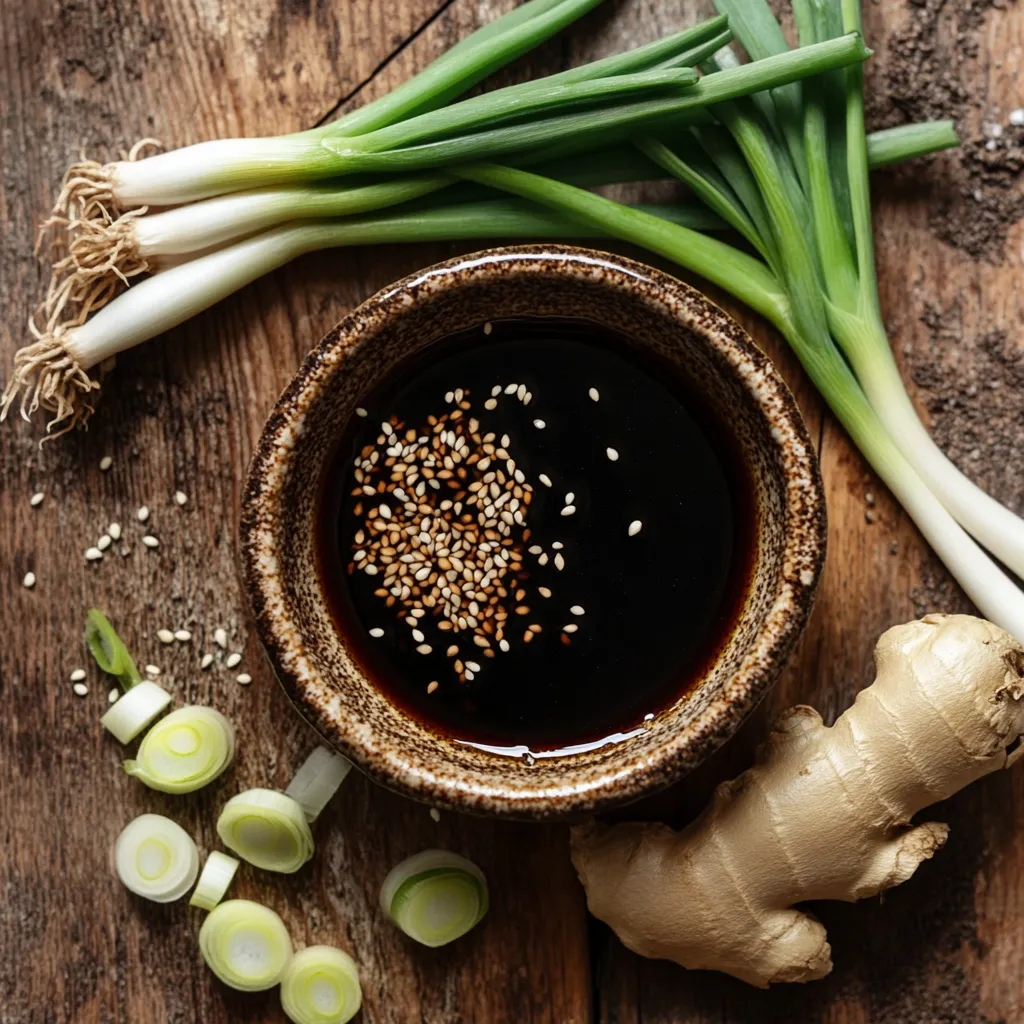Table of Contents
Dark soy sauce, a cornerstone of many Asian cuisines, is a type of soy sauce known for its thick texture, dark hue, and slightly sweet flavor. Unlike light soy sauce, which is saltier and lighter in color, dark soy sauce is brewed with added molasses or caramel for richness and depth. Originating in China, this variety has traveled far and wide, adding a bold twist to recipes worldwide.
Its role goes beyond just flavor—dark soy sauce enhances the appearance of dishes, lending them a beautiful, glossy finish. If you’ve ever wondered what gives stir-fried noodles or braised meats their deep brown sheen, chances are it’s this ingredient doing the magic.
Ingredients and Composition
The secret behind dark soy sauce lies in its carefully selected ingredients and its meticulous fermentation process. Traditional dark soy sauce is made from soybeans, wheat, water, and salt. What sets it apart is the addition of caramel or molasses, which not only darkens the sauce but also imparts its signature sweetness.
The fermentation process involves aging the sauce for an extended period. During this time, the flavors develop complexity, balancing savory and sweet notes. The result is a condiment that’s rich, aromatic, and brimming with umami, the sought-after savory taste that elevates dishes to the next level.
How Dark Soy Sauce Differs From Other Soy Sauces
Dark soy sauce stands apart due to its distinct characteristics. Compared to light soy sauce, it is less salty and significantly thicker. Sweet soy sauce, another cousin, is even sweeter and often used in Indonesian cuisine. Meanwhile, tamari, a gluten-free alternative, has a lighter color and is milder in flavor.
Understanding these differences helps you choose the right soy sauce for your dish. Dark soy sauce excels in recipes where bold flavor and rich color are desired, making it an essential pantry item for adventurous cooks and everyday chefs alike.
ypes of Soy Sauce and Where Dark Soy Sauce Fits
Different Types of Soy Sauces
Soy sauce is a broad category, with each type offering unique characteristics and uses. Light soy sauce is the most common, with a lighter color and saltier taste, making it perfect for enhancing flavor without altering a dish’s appearance. On the other hand, dark soy sauce is thicker, less salty, and packed with a deep, sweet-savory profile.
Sweet soy sauce, known as kecap manis in Indonesian cuisine, leans heavily on its sweet molasses-like flavor and is often used in marinades or stir-fries. Another popular variation, tamari, caters to those seeking a gluten-free option with a milder, cleaner taste. Each type has its place, but dark soy sauce shines when recipes call for bold flavor and a rich, caramelized appearance.
The Unique Features of Dark Soy Sauce
The allure of dark soy sauce lies in its ability to transform a dish with just a small amount. Its deep umami taste, paired with a touch of sweetness, makes it an indispensable ingredient in recipes like braised pork belly, soy sauce chicken, and chow mein.
Moreover, dark soy sauce is a culinary multitasker. It enhances the look of dishes, giving them a glossy finish, while also contributing a depth of flavor that no other soy sauce can replicate. Whether you’re experimenting with Chinese recipes or creating fusion dishes, dark soy sauce offers a flavor boost like no other.
Culinary Uses of Dark Soy Sauce
Popular Dishes Featuring Dark Soy Sauce
Dark soy sauce takes center stage in many beloved dishes. In Chinese cuisine, it’s a key ingredient in braised meats, lending them that signature dark, savory glaze. It’s also a staple in stir-fried noodles like lo mein or used as a marinade for richly flavored dishes such as Peking ribs.

Beyond its traditional roots, dark soy sauce has found its way into international kitchens. Chefs around the world use it to elevate barbecue sauces, soups, and even fusion pasta recipes, demonstrating its versatility.
How to Cook with Dark Soy Sauce
Incorporating dark soy sauce into your cooking requires a bit of finesse. Since it’s less salty than light soy sauce, it won’t overpower dishes but still delivers a punch of umami. For best results, pair it with other savory ingredients like garlic, ginger, or sesame oil to create harmonious flavors.
When using dark soy sauce, a little goes a long way. Its concentrated flavor and thick texture mean that a teaspoon or two is often enough to add depth and color to your dish. However, overusing it can lead to overly dark or sweet results. For beginners, experimenting with small amounts can help strike the perfect balance.
Choosing and Storing Dark Soy Sauce
Top Brands and Varieties
Choosing the right dark soy sauce can elevate your culinary creations. Many trusted brands, such as Kikkoman, Lee Kum Kee, and Pearl River Bridge, offer high-quality options that cater to a variety of tastes and cooking styles. Each brand has its unique take—some may lean sweeter, while others emphasize a more robust umami flavor.
When shopping, look for labels that specify “dark soy sauce” to avoid confusion with light or sweet soy sauces. Opt for products with fewer additives and preservatives for a more authentic taste. Some brands even offer premium versions brewed using traditional methods for a richer, more nuanced profile.
Storage Tips for Longevity
Dark soy sauce is a long-lasting condiment, but proper storage is key to preserving its flavor and quality. Once opened, store the bottle in a cool, dry place away from direct sunlight. Refrigeration isn’t always necessary, but it can extend the sauce’s shelf life, particularly in warm climates.
Ensure the bottle is tightly sealed after each use to prevent exposure to air, which can cause oxidation and spoilage. Check for any changes in aroma, color, or taste over time—these may indicate that the sauce has gone bad. With the right storage, your bottle of dark soy sauce can last for months, ready to add depth to your favorite dishes.
Substitutes and Alternatives
When You’re Out of Dark Soy Sauce
Running out of dark soy sauce mid-recipe doesn’t mean your dish is doomed. There are several substitutes that can mimic its unique flavor. Mixing light soy sauce with a touch of molasses or brown sugar is a quick fix. Oyster sauce, with its thick consistency and umami profile, is another viable alternative.
If you’re seeking a gluten-free option, tamari combined with a dash of honey or caramel can achieve a similar depth of flavor. While these substitutes may not perfectly replicate the taste of dark soy sauce, they’ll help you stay on track with your recipe.
Differences in Flavor and Usage
While substitutes are helpful in a pinch, it’s worth noting the differences they bring to a dish. For instance, light soy sauce lacks the sweetness and depth of dark soy sauce, while oyster sauce introduces a distinct seafood undertone. Using these alternatives might slightly alter the flavor profile, but they often blend seamlessly with other ingredients to deliver a satisfying result.
The Health Aspects of Dark Soy Sauce
Nutritional Content
Dark soy sauce is more than just a flavor enhancer; it also provides some nutritional value. A single tablespoon typically contains small amounts of protein, iron, and potassium. However, it’s important to note that sodium levels are high, so moderation is key when adding it to your dishes.
The addition of molasses or caramel not only adds sweetness but also introduces trace amounts of minerals like calcium. Despite these benefits, the primary focus of dark soy sauce is its culinary contribution rather than its nutritional profile.
Health Benefits and Concerns
Dark soy sauce is rich in antioxidants, which are known to combat free radicals in the body. Its umami properties can also enhance the overall taste of food, potentially reducing the need for added salt. This makes it a useful ingredient for people looking to cut back on sodium without sacrificing flavor.
That said, overconsumption can lead to health concerns due to its high sodium content. It’s a good idea to pair dark soy sauce with fresh, wholesome ingredients like vegetables and lean proteins to balance your meals. As always, enjoy it in moderation to make the most of its unique qualities without compromising your health.
Frequently Asked Questions About Dark Soy Sauce
What Is the Difference Between Soy Sauce and Dark Soy Sauce?
The key difference lies in their flavor, texture, and appearance. Dark soy sauce is thicker, sweeter, and less salty compared to light soy sauce. It’s often used for braising or adding a deep color to dishes, while light soy sauce is better suited for seasoning and enhancing flavors subtly.
What Can I Use Instead of Dark Soy Sauce?
If you don’t have dark soy sauce on hand, you can substitute it with a mix of light soy sauce and molasses or brown sugar. Oyster sauce and tamari with a dash of caramel also work well, though they may slightly alter the dish’s flavor.
Is Kikkoman a Dark Soy Sauce?
Kikkoman is primarily known for its light soy sauce, but the brand also offers dark soy sauce varieties. Be sure to check the label to confirm whether it’s light or dark before purchasing.
What Is Dark Soy Sauce Used For?
Dark soy sauce is versatile and used for various purposes, such as marinating, braising, and stir-frying. It’s perfect for creating richly flavored dishes and giving food a glossy, dark appearance, making it a favorite in Asian and fusion cuisines.
For more culinary inspiration, check out recipes like our chicken and shrimp stir-fry at aprecipes.com.
Cooking Tips and Techniques for Dark Soy Sauce
Enhancing Flavors with Dark Soy Sauce
Dark soy sauce is more than just a condiment; it’s a flavor enhancer that can elevate any dish. To make the most of it, start by using small amounts and adjust gradually. Its deep umami flavor and slight sweetness work best in dishes like stir-fried noodles, braised meats, and soups.

When marinating proteins, combine dark soy sauce with garlic, ginger, and a splash of sesame oil for an irresistible taste. If you’re braising, a couple of tablespoons can transform the dish, creating a glossy, flavorful sauce that coats every bite.
Common Mistakes to Avoid
While dark soy sauce is versatile, it’s easy to overdo it. Adding too much can overpower your dish, making it overly sweet or dark. To avoid this, always start with less and taste as you go.
Another mistake is using dark soy sauce as a standalone ingredient for seasoning. Its flavor pairs best when balanced with acidic or spicy components, like vinegar or chili paste. Finally, keep in mind that dark soy sauce doesn’t replace light soy sauce in recipes that require a lighter flavor or color.
Exploring the Global Appeal of Dark Soy Sauce
Dark Soy Sauce in Fusion Cuisine
Although it’s a staple in Chinese and Southeast Asian kitchens, dark soy sauce has found a place in global cuisine. Chefs worldwide have embraced its unique flavor to create fusion dishes, blending traditional Asian elements with Western favorites. For instance, it’s often used to enrich barbecue sauces, glaze meats, or even enhance pasta dishes.
In desserts, adventurous cooks are experimenting with dark soy sauce to add depth to caramels and chocolates. This creative use highlights its versatility and shows that it can go beyond savory dishes.
Pairing Dark Soy Sauce with Other Ingredients
Dark soy sauce pairs beautifully with bold, robust flavors. Ingredients like garlic, scallions, and sesame oil complement its sweetness and enhance its richness. In contrast, acidic elements like lime juice or rice vinegar provide balance, preventing dishes from becoming too heavy.
When planning your meals, consider pairing dark soy sauce with fresh vegetables, tofu, or hearty proteins like beef and pork. These combinations allow its unique flavor to shine while maintaining harmony in your dish.
For more tips on creative ingredient pairings, check out the recipes at allrecipes.com

